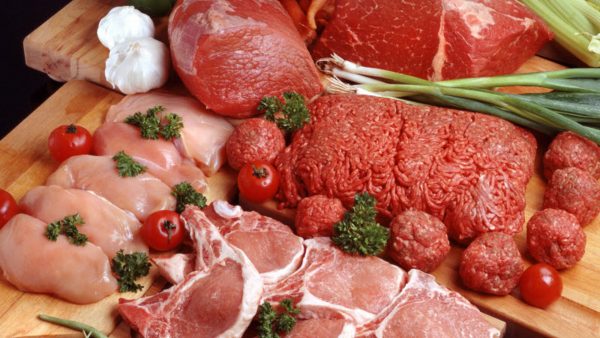Introducing Meat to Your Baby: When and How
Meat is highly important for a developing body, as it is rich in proteins, which are essential building blocks for tissues and cells. Meat contains a large number of nutrients: vitamins, amino acids, phosphorus, iron in an easily digestible form. These substances are necessary for the full functioning of the nervous system, the formation of strong bones and muscular system, for sharp vision.

Since the 7th month, your baby needs to exercise his gums and teeth. Meat introduction will teach your baby to adult food and contribute to the development of milk teeth and chewing muscles.
Every child is unique, so every mother has to decide when and what to introduce to her baby. Still there is some basic advice.
When to begin?
Not earlier than at 7−8 months. Immature intestine must first learn to digest fruit, vegetable and cereal menu. You can introduce meat seven weeks after introducing first vegetables or cereals. Introduce meat when the baby is healthy, feels good and has no problems with the gastro-alimentary tract. Follow the baby-feeding chart.
Babies with low hemoglobin or those with signs of rickets can start eating meat a little earlier — at 6 months. If you bottle-feed your baby, start giving meat at 7 months, as he may lack for nutrients.
Do not hurry with the introduction of meat into the diet of your baby as it can do more harm than good.
What meat to begin with?
Start with rabbit meat or turkey. Rabbit meat has more vitamins and minerals (especially iron) than other types of meat. Low fat content is also a benefit for your baby. Turkey is the second in the meat-list for your baby. It rarely provokes rash or other allergic manifestations. Turkey stimulates blood vessels and heart muscle, enhance immunity and increases appetite. Turkey puree is tasty and healthy.

After rabbit and turkey, you can add veal or beef. They are rich in iron, zinc, copper, sodium, phosphorus, magnesium, potassium and cobalt. Veal contains quite a large amount of carotene. Not all babies like beef puree.
Later, you can add chicken, pork and horsemeat. Chicken is rich in essential amino acids and trace elements. Try to buy fresh (not frozen) chicken. Chicken and pork can cause allergies — watch your child carefully!
In a few months, you can add liver, tongue, brain, but not kidneys. Veal, beef and lamb liver are equivalent in nutritional properties. They are rich in valuable protein, vitamins and iron. Such complementary foods are especially useful for children who suffer from anemia.
Lamb is not suitable for babies, as it has many fats, which are difficult to digest.
You must always begin with one type of meat and watch the reaction.Carefully choose the first meat for babies. Analyze your baby’s health and his reaction to the already introduced complementary foods. Allergic reactions require special attention. If your baby is allergic to cow milk protein (has lactose intolerance), an unwanted allergic reactions can occur to beef. So don’t give it to your baby until 18 months. Find a safe alternative — rabbit or turkey.
How to introduce meat?
Introduce meat gradually, starting with half a teaspoon. If there is no allergic reaction and no problems with stool, increase the amount to 30 grams per day. One-year-old baby can get up to 80 g of meat per day. Give your baby meat in the morning or in the afternoon.
Giving your baby meat for the first time, you may face a problem: your baby may vomit. To avoid this, mix meat with vegetable puree or with breast milk or formula to make its consistence thinner. Give your baby first teaspoon of meat before feeding him. Later the baby will be able to eat mashed meat without vegetables, but he needs time.
The meat for the first feeding should be boiled and carefully ground. Skin rashes and redness, disorders of the stool, frequent regurgitation and crying may indicate intolerance of this kind of meat. You can also start with purchased homogenized meat puree.
How to choose meat puree?
- Pay attention to the degree of meat comminution. If you only begin to give meat to your baby, choose homogenized mono meat puree without additives.
- Keep in mind the allergic status of your baby.
- Thinner puree is better for babies who only start to eat meat.
- You can store an open can in the refrigerator no more than a day.
- Preheat the canned meat in a water bath.
- Always taste the puree before giving it to your baby.
How often can I give meat to my baby?
You can give lean beef and veal every day, poultry (turkey, chicken) — 1−2 times a week. Pork — 3 times a week. Sometimes chicken causes allergic reaction — in this case it is better to prepare another dish — rabbit or lean pork.
Do not combine meat with cottage cheese and yogurt. Chicken egg yolk is also better to offer together with cereals. Remember the principle of diversity. Do not focus on any one meat, even if your child likes it very much.
How to cook meat for babies?
Use only fresh meat. Grind it twice, then divide into small portions, and freeze. It is very convenient: you won’t need to grind meat every time you want to feed your baby.

Take a portion from your refrigerator and boil it until soft — about 20−25 minutes. Drain the broth through a sieve. Put the meat from the sieve into a bowl. Add breast milk, formula or vegetable puree and use a blender. After 11 months, your baby will be able to eat pure meat puree — without vegetables or formula.
Do not store meet puree!
After 11 month, you can add a little salt.Various spices (celery, basil, dill, parsley, parsnips, tarragon) give meat a nice flavor. If you prepare meat yourself, be careful with these spices: the child’s body is not ready to a pronounced spicy taste. Do not use pepper. After 10 month, you can add a little braised onions or garlic. It’ll make meat dishes for your baby delicious and healthy.
What about introducing meat broth?
It’s better not to give your baby meat broth often as it is a concentrate extract of fats. Broth is a severe challenge to your baby’s pancreas and liver. Early introduction of meat broth (especially chicken broth) can cause exudative diathesis.
Vegetable soup is better for children under 18 months.
Meat broth contains a large amount of extractives, which are strong stimulants for digestive processes. As the nutritional value of broth is not too large, it is given with or before vegetable puree.You need to cook meat and poultry in two waters. Don’t use the first broth for feeding babies, because it contains harmful substances and much fat. Introduce meat broth adding half a teaspoon a day.




